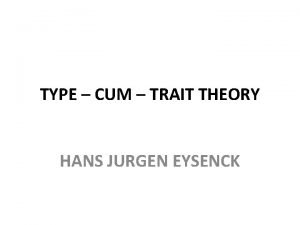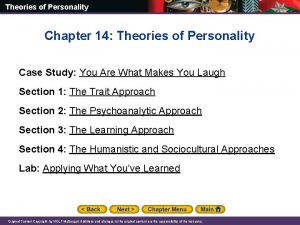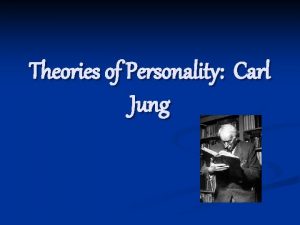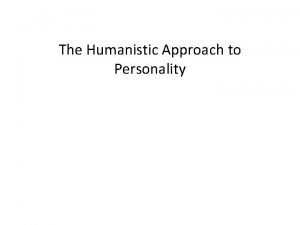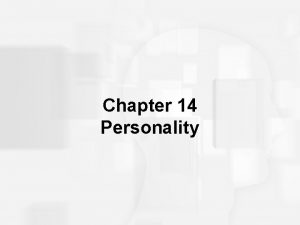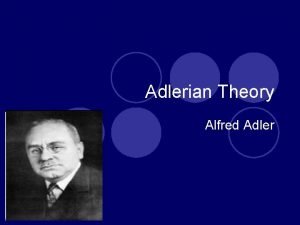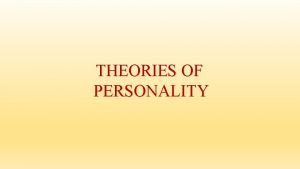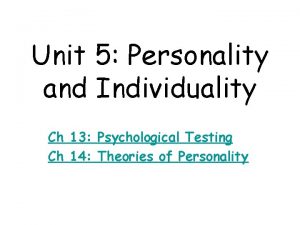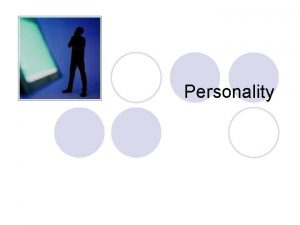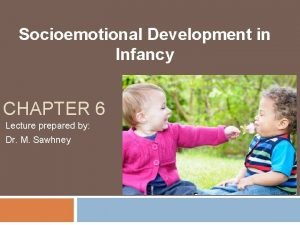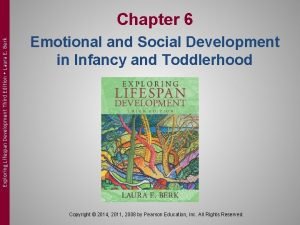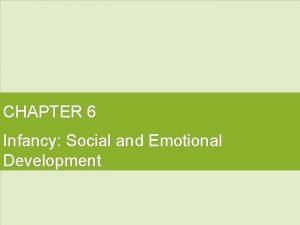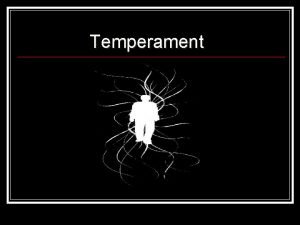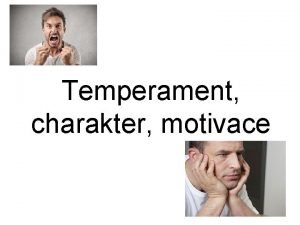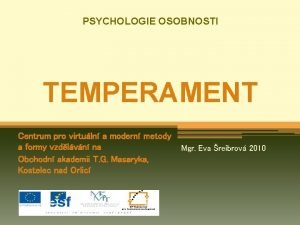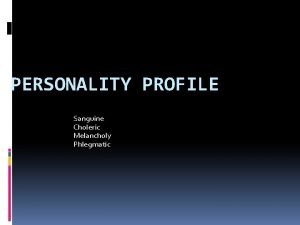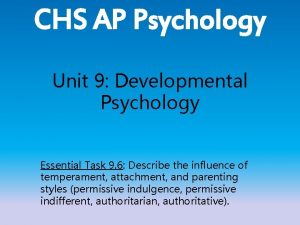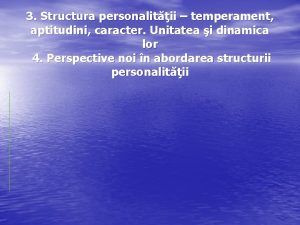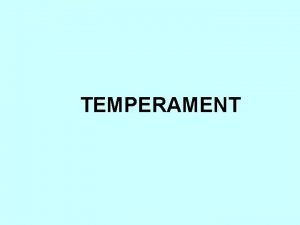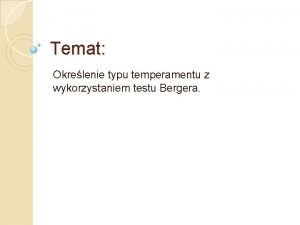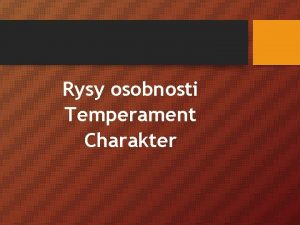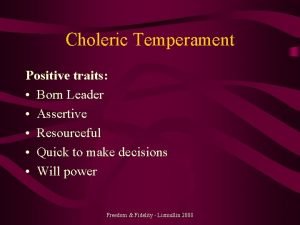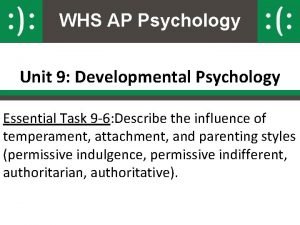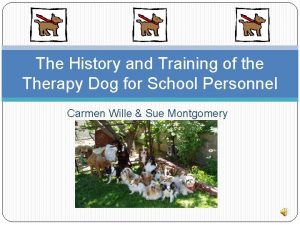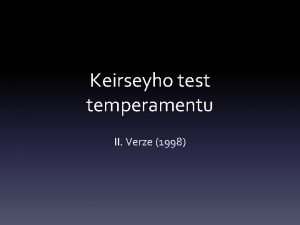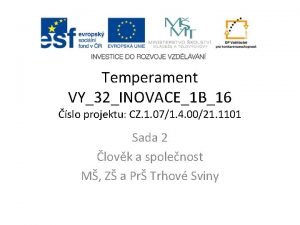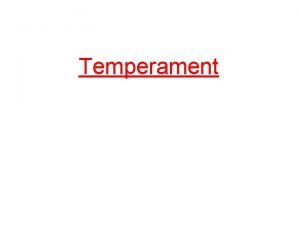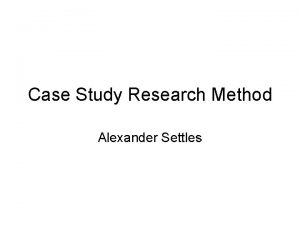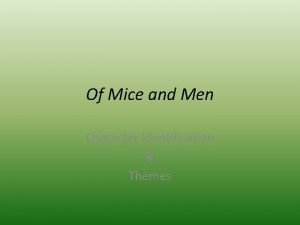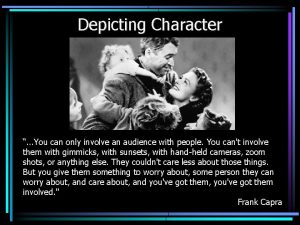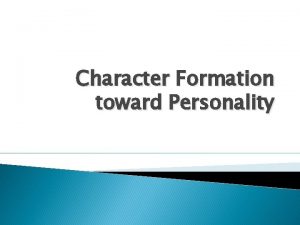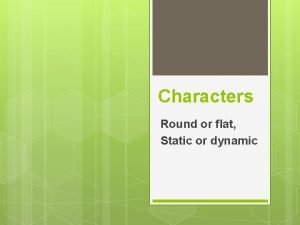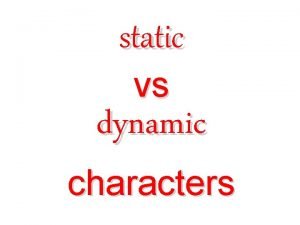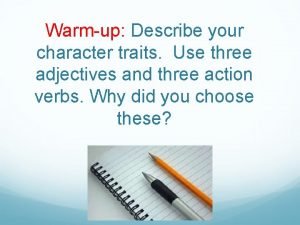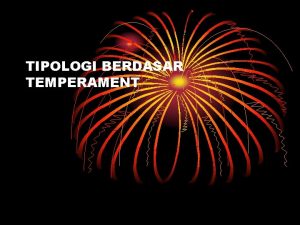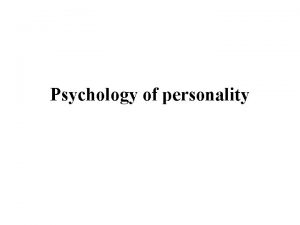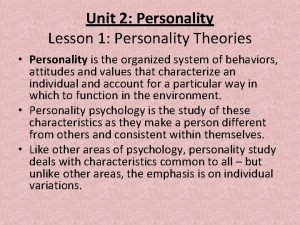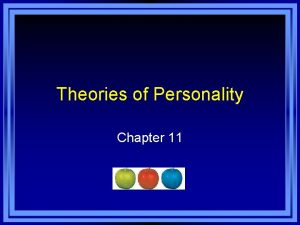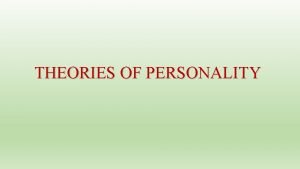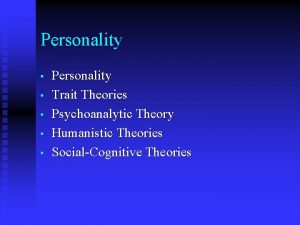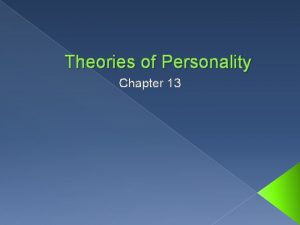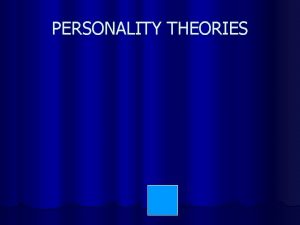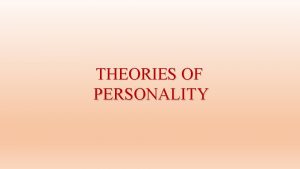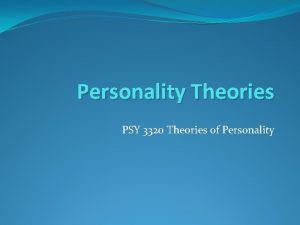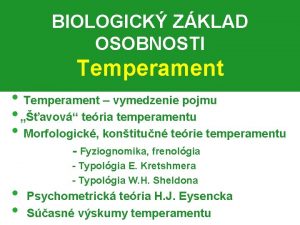Personality Theories A Study in Character and Temperament





















































- Slides: 53

Personality Theories: A Study in Character and Temperament Summer, 2018

Course Intro and Overview • For Discussion – What is personality? – How would you describe your personality? – How does personality develop? – What is the relationship between personality and psychotherapy? – What are some ‘big ideas’ in personality psychology? – What do you want out of the course? • Go Over Syllabus

Brain, Mind, Behavior Human Indiv/Relational A Map of Psychology Sociology(Above) (Social Science) Professional Psychology ~~~~Anthropology (Hum Beh) Clinical Human Psychology Counseling Cultural School Applied Psychology Social Educational Personality Ind/Org Human Developmental Sport Human Cognition Licensed Health Pract. Health ~~~~~~ Forensic Basic Psychology Psychopathology (Basic) Cognitive/Comp. Science Comparative Psychology Ethics, Consultation, Behavioral Science Advocacy, Education, Psychophysiology/Psychophysics Scientific Worldview Behavioral Genetics Research Methods ~~Ethology /Sociobiology (Ani Beh) Stats, Measurement, Neuroscience (Below) Research Design (Natural Science) Practice Skills Research Skills

Fundamental Questions of Personality

Personality: What is it? • Personality is the organized, developing system within the individual that represents the collective action of that individual’s major psychological subsystems. (Mayer)

Personality: How Should We Teach It?

Theory by Theory: Major Perspectives in Personality • • • Psychodynamic Humanistic Learning/Behavioral Cognitive Trait Biological

Units, Domains and Whole Picture Analyses • Traits – dominant tendencies that vary across individuals • Motives – energizing forces that drive behavior • Cognitive – Information processing systems that take inputs, form computations and lead to outputs • Whole Person Unit Models – Attempt to model the entire personality system

Consciousness and Attention Self Awareness Self-attention & Self-monitoring Defense and Coping Dynamic Re-evaluations of Self Conscious Self-Control Pure Awareness Direction of Attention Working Memory Short term memory Span of Apprehension Models of the Self-Concept Life-Story Memory Self-Related Aspects of Long-Term Memory Social Skills Strategic self-presentation Acting Ability Social Role Knowledge Social Relationship Enactment Attachment System Cognitive Intelligences Expectations and Blueprints for Interacting with Others Verbal Intelligence Perceptual-Organizational Intelligence Spatial Intelligence Models of the World Beliefs, Attitudes & Attributions Expectancies & Predictions General Knowledge In Long-Term Memory. Imagination Daydreaming Fantasizing Emotion System Constructed Emotions Basic Emotional Responses and Emotional Expressions Hot Intelligences Creativity Emotional Intelligence Social Intelligence Motivation System Constructive Channeling of Motives Basic Biologically-based and Learned Motives Motivational/ Emotional Social Expressions Shyness or Extroversion Dominance or Submission Grace or Clumsiness Mayer’s integrated component systems model

Personality Theorists need to be able to explain how someone is… • like all other people (the general architecture of human nature) • like some other people (the nomonthetic ways in which the general architecture develops and then gives rise to individual differences) • like no other person (the unique, idiographic constellation, experience and identity of the specific person)

Key Controversies/Issues • Freud/psychiatry versus Scientific Psychology • Idiographic versus nomothetic • Experimental versus correlational versus case study • Genetics versus Learning • Evolution versus Culture • Person versus Situation • Traits versus Character

Temperament (Traits) vs. Character Temperament refers to the broad and general dispositions of an individual (traits), whereas character refers much more to one’s unique identity and what is learned in particular situations. Personality research and theory has varied in terms of its focus… It has gone from focusing on character to focusing on temperament and more recently back to character again…

Personality Psychology • Freud’s theory and that of his followers were theories of character. So too were the frames from the Humanists like Maslow and Rogers. • However, since the 1950 s, trait theory emerged and gained prominence. The Big Five probably represents the most prominent academic approach to personality in the last 30 years…

Five Factor (Trait) Model Dimension High End Low End Extraversion Positive emotions, energetic, sociable, adventurous Reclusive, quiet, shy, cautious Neuroticism Negative emotions, Calm, relaxed, stable perceives threats, reactive Agreeableness Sympathetic, polite, goodnatured, soft-hearted Tough-minded, rude, irritable, hostile Conscientiousness Well-organized, high achievement strivings, careful, disciplined Disorganized, irresponsible, careless, impulsive Openness Imaginative, independent, having broad interests, receptive to new ideas Conforming, practical, narrow interests, closed to new ideas

Although prominent in research, many psychologists have been critical of the Big Five for many reasons. Not in the least because it offers a very crude picture of personality. It is also basically atheoretical. And, argued Walter Mischel, behavioral consistency of the kind suggested by trait theory was actually very limited.

Walter Mischel and the Person. Situation Debate Is how you act a product of your personality or of the situation? While trait theories search for consistencies in people’s behavior across situations, social behavior theory seeks order and regularity in the form of general rules that relate environmental changes to behavioral changes…Behavior depends on the stimulus conditions and is specific to the situation. Walter Mischel, 1968

Personality and Social Psychology are Defined Somewhat Against One Another on the P v. S Debate Human Psychological Behavior = f(Person X Environment) Personality Psychology • Emphasizes the “P” • Individual Differences • Consistency of Behavior Patterns Across Situations • Research is Correlational, Longitudinal, and Clinical/Qualitative Social Psychology • Emphasizes the “E” • General Tendencies • Situational Influences • Inconsistency of Behavior Depending on Situation • Research is more Experimental

In his own words… “The greatest irony of my professional life is that my 1968 monograph Personality and Assessment, which brought me quick fame and even more infamy, is credited with causing an endless debate I found absurd from the start, splitting the two fields I hoped it would unite…Within a year the "person versus the situation debate" exploded and dominated much of the agenda in personality and social psychology. This heated confrontation filled the journals' pages and the field's national and international meetings for more than 15 years, and deepened what to me was the absurd conceptual split between person and situation and between personality psychology and social psychology. . . “I thought both sides equally missed the point and the intended 1968 message. If there's a lesson to be learned from this story, perhaps it's that a paradigm challenge will either be ignored, or create a lot of noise and strife, but will change little until a better alternative emerges and gets a chance. ” Walter Mischel, 2011

The Cognitive-Affective Personality System (CAPS) Model • Mischel, Shoda and colleagues developed the CAPS approach. In it, they conceive of the Personality System as a set of If…then behavioral rules that are activated in a particular situation. • They argue behavior is consistent, but is contextually dependent and acquired. Thus, it is not that Johnny has the trait of ‘defiance’, but he may be consistently defiant when teachers try to control him. He may well not be defiant with his friends or in other kinds of situations. • Mischel and Shoda argue that the If…then rules are complex networks of expectancies, beliefs, goals and drives, and emotions, that are activated by particular stimuli and contexts.

The Cognitive-Affective Personality System (CAPS) Model

From a traditional personality perspective, trait theorists are talking temperament, and CAPS is about character… Indeed, precisely such a point was made by in an American Psychologist article by Mc. Adams and Pals…

For Mc. Adams and Pals, Personality is… • (1) an individual’s unique variation on the general evolutionary design for human nature, expressed as • (2) dispositional traits, • (3) characteristic adaptations (i. e. , situational If…then rules), and • (4) self-defining life narratives developed and differentiated in • (5) the culture and social context.

M & P’s Bio. Psycho. Social Frame for Personality Psychology The Sociocultural Context The Developmental Context Identity Char. Adapt Traits Mc. Adams and Pals note that “there exists no definitive, Big Five–like list of these kinds of constructs”. I realized I had developed precisely such a frame!!! The Evolutionary/Genetic Context

Some UTUA Considerations

J I I Dynamics Investment Influence Investment


The Concept of a Person As the descriptive psychologist Peter Ossorio makes crystal clear in his wonderful manuscript, The Behavior of Persons, the concept of a “person” is very different than the concept of an organism or animal. Ossorio explains why, conceptually, a person is a deliberative actor on a social stage. The behavior of people is defined, paradigmatically, by “intentional action”, which means the self-conscious justification of a deliberative act. For example, the act of writing this blog is paradigmatic (this is Ossorio’s way of talking—it means full example) of intentional action. I, the person of Gregg Henriques, am someone with a history of deliberative action. I am self-consciously justifying my intentional action of giving this lecture to achieve a goal and can explicate that justification to myself and others as necessary and appropriate.

CAST, the Character Wheel, and the relationship between Personality and Psychotherapy

A Bio. Psycho. Social Frame for Professional Psychology The Sociocultural and Relational Context The Developmental Context Personality Psychotherapy Psychopathology The Neurobiological Context

CAST as a Key Bridge Between Personality and Psychotherapy Personality Five Systems of Characteristic Adaptation

CAST Approach to Conceptualizing People Five Systems of Adaptation

Character Wheel


Five Factor (Trait) Model Dimension High End Low End Extraversion Positive emotions, energetic, sociable, adventurous Reclusive, quiet, shy, cautious Neuroticism Negative emotions, Calm, relaxed, stable perceives threats, reactive Agreeableness Sympathetic, polite, goodnatured, soft-hearted Tough-minded, rude, irritable, hostile Conscientiousness Well-organized, high achievement strivings, careful, disciplined Disorganized, irresponsible, careless, impulsive Openness Imaginative, independent, having broad interests, receptive to new ideas Conforming, practical, narrow interests, closed to new ideas

Identity/Ego Development/Executive Functioning Degree of Insight Degree of Agency/Self-directedness Degree of Self-Esteem/Acceptance/Compassion Degree of Empathy Degree of Integration, Purpose and Thematic Coherence • Degree of Philosophical and Moral Development • Lovinger’s Developmental Ego perspective • • •

Character Strengths and Virtues

Abilities • • • Intellectual Capacities Achievement Capacities Personal, Social, Emotional Abilities (EQ) Creative, Musical, Artistic Skills Athletic

Vulnerabilities/Pathologies • • Personality and Relationship Problems Mood and Emotion Problems (Dep, Anx) Cognitive Processing (Memory/Attention) Behavioral Problems – Sleep hygiene, eating, Substance Use, Impulsive acting out, compulsions • Disorders of Consciousness/Psychosis (Hallucinations/Delusions) • Traumas, Injuries and Losses • Psycho-Neuro-developmental problems

The Pervin Chapters

The Enterprise of Personality Research The Three Primary Modes of Inquiry Experimental, Correlational, Clinical Case Study In the experimental approach the goal is to produce consistent variation in behavior as a result of treatments or manipulations of independent variables… Individual differences have been an annoyance rather than a challenge to the experimenter. In contrast, the correlational approach takes existing individual differences to be the crux of the matter and regards situational effects as the source of annoyance. In short, “The correlational psychologist is in love with just the variables the experimenter left home to forget. ”

The Enterprise of Personality Research The clinical/case study approach Emphasizes person as a whole, naturalistic observation. Also should emphasize prescriptive setting…individuals seeking and being offered help. “Many would argue that it is Freud’s clinical observations, rather than his theoretical formulations, that show his true genius. ” “We can no more test Freudian hypotheses than [compare] Einstein and Newton by falling asleep under an apple tree”

The Enterprise of Personality Research The Correlational Approach Emphasizes statistical methods to establish the association between measures on which individuals have been found to differ. Examples: Intelligence, Trait Theory, Self-Report Data

The Enterprise of Personality Research The Experimental Approach Emphasizes the systematic manipulation of variables to establish causal relationships Behavioral and Social Psychology (e. g. , cognitive dissonance)

The Enterprise of Personality Research Theory, Data, and Research Approach are inevitably linked! There is considerable evidence of a linkage among theory, research method, and data such that proponents of one theoretical point of view are led to the investigation of some phenomena rather than other phenomena, emphasize the strengths of the research method associated with that point of view and the weaknesses of alternative approaches, and are drawn to conclusions concerning personality functioning that may differ from those drawn from the utilization of alternative methods.

The Enterprise of Personality Research The results we find will depend on the investigator involved, on the method being employed and on the topic being researched. But the results will also depend on the interaction of these variables. Some investigators will employ some methods more skillfully or insightfully than others, some investigators will have better understanding of certain topics, and some topics will be better approached by some methods. — Lee Sechrest

The Enterprise of Personality Research The justification for multiple methods: From this panorama of methods our principal conclusion can be that there is no “one and only” method for studying personality. All methods have their value, most of them being adapted to the exploration of one special aspect of the problem. The wise investigator will not place his faith in any one exclusively, but will use several to cover more ground, and at the same time to check the findings of each method against those of another.

The Enterprise of Personality Research A “random” example that cuts across methods: An Experimental Analysis of the Role of Cognitive Errors in the Development of Depressed Mood Following Negative Social Feedback

What Units Shall We Use? Traits refer to the regularities or broad behavioral consistencies in the conduct of people. As such, traits represent the basic categories of individual differences in functioning. Catell, Allport, Eysenck Big Five Neuroticism, Extraversion, Openness, Agreeableness, Conscientiousness

What Units Shall We Use? What is striking about the proponents of the {five factor} model is the extent to which they view the field of personality as now defined by these basic trait dimensions and there associated measures.

What Units Shall We Use? Motive constructs have been used to address: 1. What activates the organism? 2. Why does the organism engage in one particular activity rather than another? 3. Given the same stimulus, why does the organism respond sometimes one way and sometimes another?

What Units Shall We Use? Varieties of Motivational Approaches Pitchfork-Drive Freud, Hull Carrot-Incentive Goal Theory Cognitive Kelley Neuro-economic Behavioral Investment Theory

What Units Shall We Use? Cognitive Units of Personality Social Cognition: Expectancies, Beliefs and Attributions Self-Efficacy (Bandura) Maladaptive Cognitions (Beck, Ellis)

What Units Shall We Use? What are the Relationships between the units? … “The greatest challenge for the future of the field is to establish not only the units of personality but the ways in which they function as parts of an organized system—at times integrated with one another and at times in conflict, but always interacting”
 Trait theory of personality
Trait theory of personality What does the psychoanalytic approach to personality teach
What does the psychoanalytic approach to personality teach Theories of personality carl jung
Theories of personality carl jung Humanistic personality
Humanistic personality Freudian personality test
Freudian personality test Trait theory consumer behaviour
Trait theory consumer behaviour What is adler's theory of personality
What is adler's theory of personality Allport personality theory
Allport personality theory Raymond cattell was a psychologist who ________.
Raymond cattell was a psychologist who ________. L
L Thomas and chess temperament
Thomas and chess temperament Thomas and chess temperament
Thomas and chess temperament Thomas and chess temperament
Thomas and chess temperament Thomas and chess temperament
Thomas and chess temperament Melancholik charakteristika
Melancholik charakteristika Melancholik cechy
Melancholik cechy Temperament vs charakter
Temperament vs charakter übez
übez Temperament zahamowany
Temperament zahamowany Premorbid temperament
Premorbid temperament Sanguine strengths and weaknesses
Sanguine strengths and weaknesses Temperament ap psychology
Temperament ap psychology Pyknik astenik atletik
Pyknik astenik atletik Portrete temperamentale
Portrete temperamentale Perfekcyjny melancholik
Perfekcyjny melancholik Melancholik
Melancholik Temperament wladik
Temperament wladik Dział mechaniki opisujący ruch ciał
Dział mechaniki opisujący ruch ciał Assertive temperament
Assertive temperament Parents impose rules and expect obedience
Parents impose rules and expect obedience Name
Name Temperament psychology
Temperament psychology History of pet therapy
History of pet therapy Temperament
Temperament Keirsey temperament test
Keirsey temperament test Resilient temperament definition
Resilient temperament definition Hippokrates temperament
Hippokrates temperament Sangvinik význam
Sangvinik význam Relatia dintre temperament si aptitudini
Relatia dintre temperament si aptitudini Eysenckova typologie
Eysenckova typologie Robert yin case study
Robert yin case study Differentiate between personality and character
Differentiate between personality and character Soliloquy literary term
Soliloquy literary term What is the theme of mice and men
What is the theme of mice and men Character traits physical and personality
Character traits physical and personality Define character formation
Define character formation Confidant examples
Confidant examples George of mice and men-character personality traits
George of mice and men-character personality traits Jelaskan pengertian etika dan kepribadian
Jelaskan pengertian etika dan kepribadian Tragedy is a drama which ends on
Tragedy is a drama which ends on Flat/static character
Flat/static character Static characters examples
Static characters examples What is direct characterization
What is direct characterization Indirect character traits
Indirect character traits
